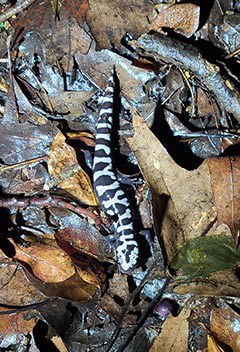Adult marbled salamanders discovered in Middlesex Fells by Zoo New England’s Field Conservation Team
Friday September 29, 2023
 On two recent rainy September evenings, members of Zoo New England’s (ZNE) Field Conservation Team went deep into the Middlesex Fells to search for migrating marbled salamanders. The team, alongside local biologist and nature enthusiasts, including Earthwise Aware, was hoping to catch a glimpse of the amphibians during their breeding and egg laying season. The discovery of five mature salamanders was a huge cause for celebration, as this was the first time adult marbled salamanders have been seen in this area since the 1930s.
On two recent rainy September evenings, members of Zoo New England’s (ZNE) Field Conservation Team went deep into the Middlesex Fells to search for migrating marbled salamanders. The team, alongside local biologist and nature enthusiasts, including Earthwise Aware, was hoping to catch a glimpse of the amphibians during their breeding and egg laying season. The discovery of five mature salamanders was a huge cause for celebration, as this was the first time adult marbled salamanders have been seen in this area since the 1930s.
Middlesex Fells, which is right next to Stone Zoo, is one of the former homes of marbled salamanders in northeastern Massachusetts. During the 1930s, the salamanders became locally extinct when increasing urbanization made the habitat unsuitable for them.
In 2016, ZNE’s Field Conservation Team released the first group of young marbled salamanders in the Fells, possibly the first members of their species to occupy the area in 80 years. This was possible with the help of the Massachusetts Division of Fisheries and Wildlife, Medford High School, Friends of the Fells and the Massachusetts Department of Conservation and Recreation.
In February, a volunteer biodiversity survey by Zoo New England’s partner organization Earthwise Aware found a larval salamander at one of the Fells’ vernal pools, the first sign that some of ZNE’s released juveniles effectively matured, found one another, and laid eggs. Subsequent surveys by ZNE biologists revealed more larvae.
The team’s recent sighting of healthy adult marbled salamanders is another huge milestone in the reintroduction of this species.
"This is such a thrill for our team, and is very rewarding after years of work reintroducing this species to the Middlesex Fells," said John Berkholtz, Senior Field Conservationist at Zoo New England. "These are the first adult salamanders that we have seen, and it was really like finding a needle in a haystack. This discovery shows that our conservation efforts are paying off."
This exciting discovery will help ZNE’s field biologists map out sites of salamander activity in the Fells and look for changes in the population over time. With continued reintroduction efforts, the goal is to have a flourishing population in the future.
Until the discovery of the marbled salamander larvae this past spring, this species hadn’t been seen in the Fells or in surrounding communities since the 1930s. The adult marbled salamanders recently found in the Fells will contribute to the overall health and diversity of their ecosystem and support the overall stability of the wetland habitat they call home.
Salamanders perform a vital role in what scientists call "nutrient cycling:" their amphibious lifestyle allows them to bring nutrients from aquatic ecosystems to terrestrial (dry land) ones, enriching both in the process. Like all amphibians, salamanders' sensitive skin makes them one of our best ecological "early warning" systems for water and air pollution, as they begin to show signs of trouble before other species do.
The marbled salamander is a relatively large salamander ranging from Florida to southern New Hampshire. They are listed as a threatened species in Massachusetts and as a critically endangered species in New Hampshire.
Photo by Tim Beaulieu

